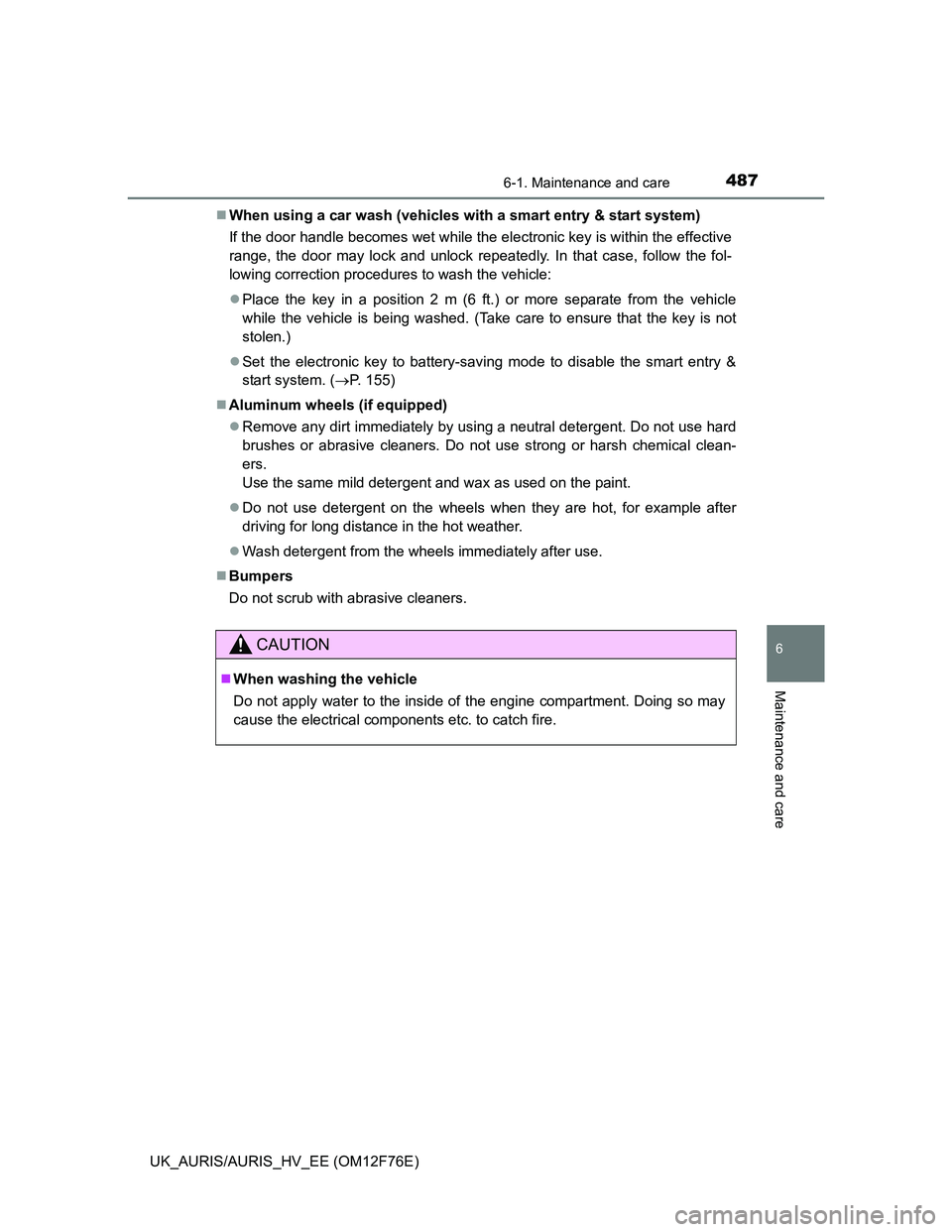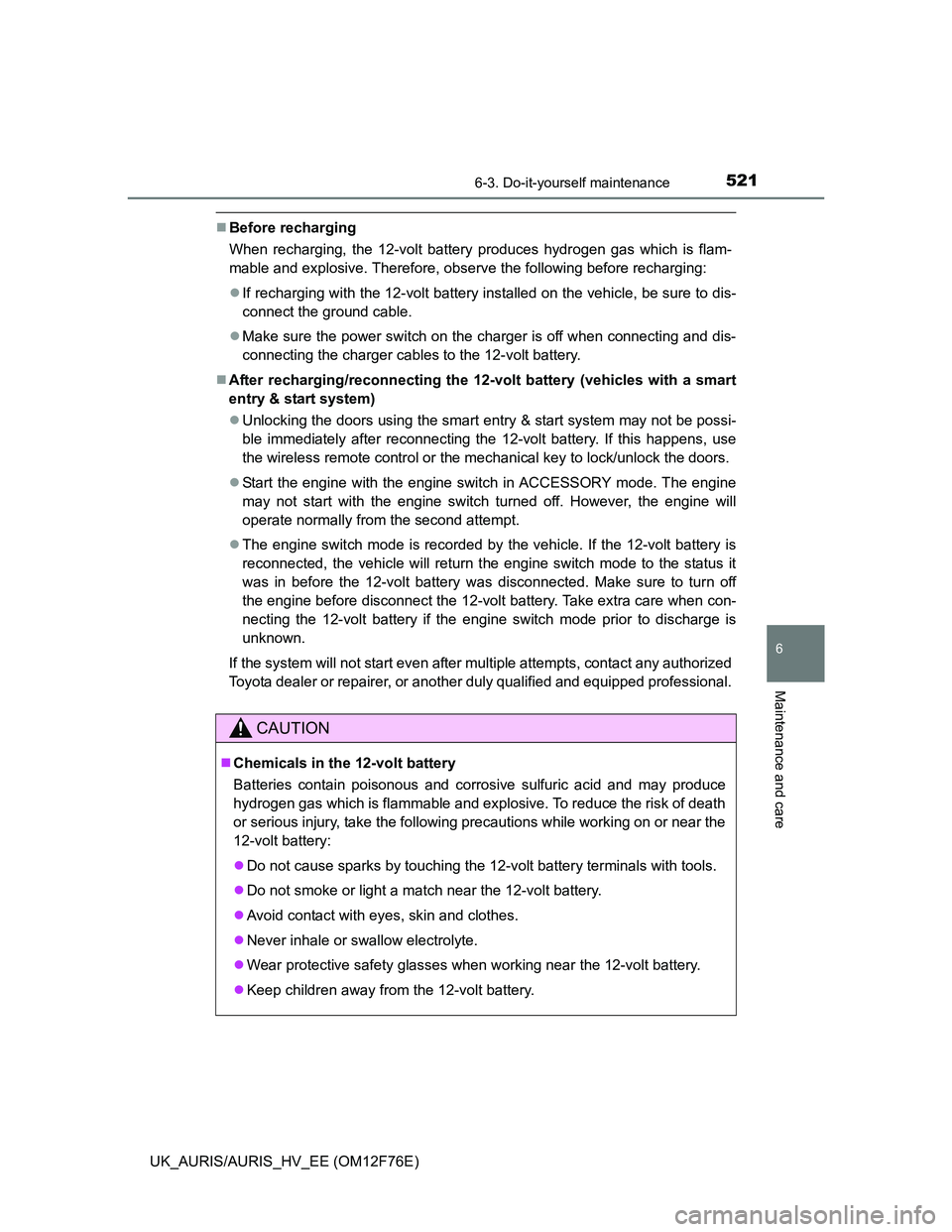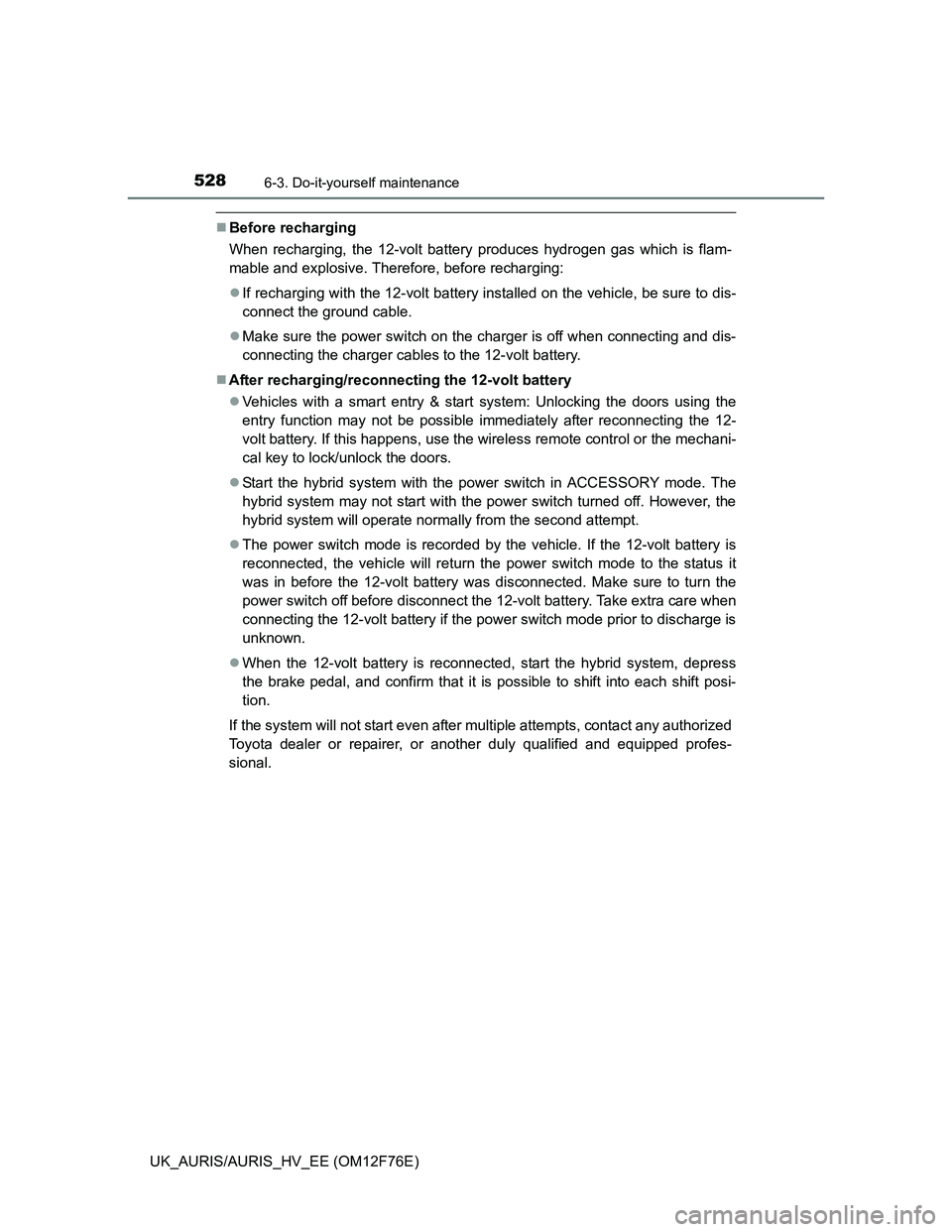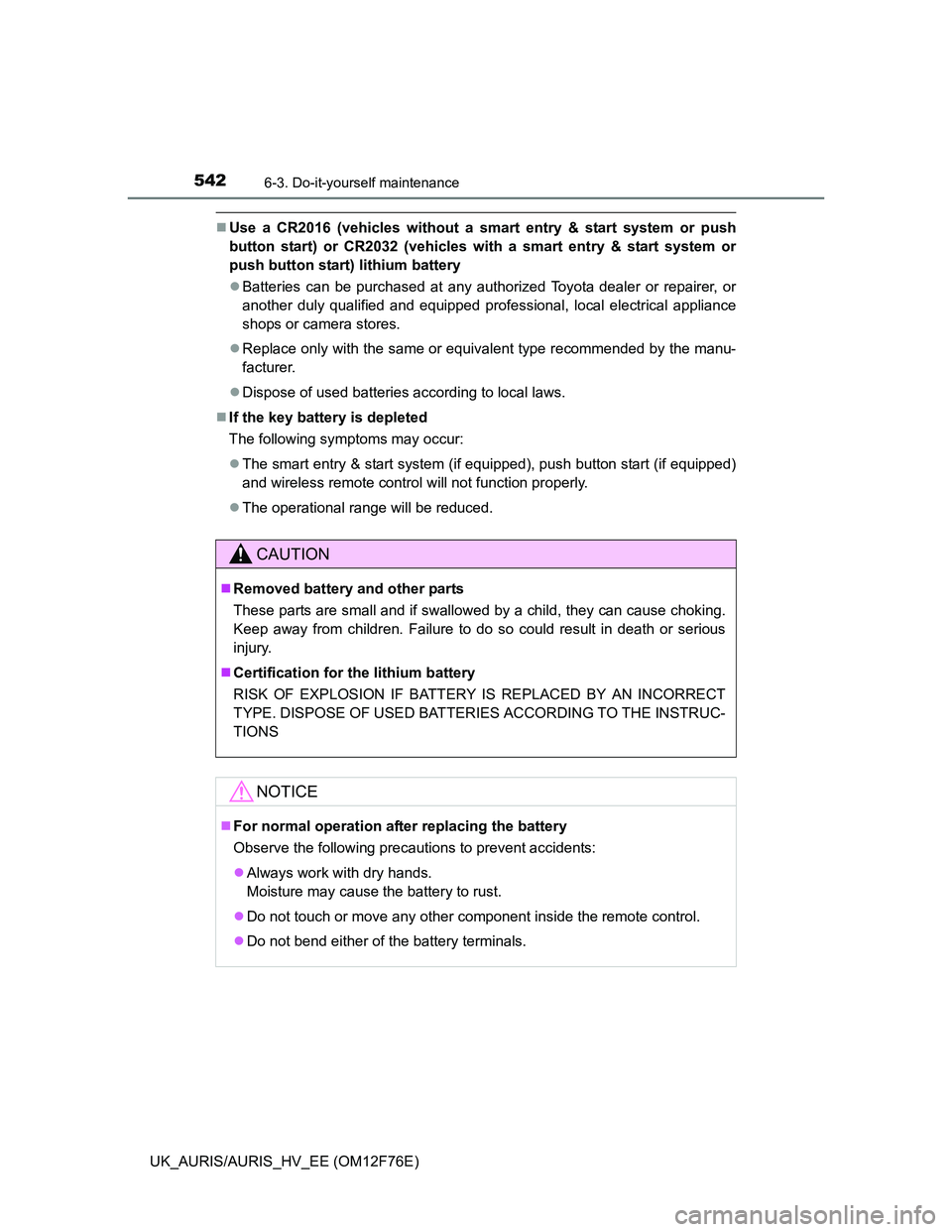Page 485 of 768
485
6Maintenance and care
UK_AURIS/AURIS_HV_EE (OM12F76E)6-1. Maintenance and care
Cleaning and protecting
the vehicle exterior .......... 486
Cleaning and protecting
the vehicle interior ........... 490
6-2. Maintenance
Maintenance
requirements.................... 493
6-3. Do-it-yourself
maintenance
Do-it-yourself service
precautions ...................... 496
Hood .................................. 500
Positioning a floor jack ....... 502
Engine compartment.......... 504
12-volt battery .................... 526
Tires ................................... 531
Tire inflation pressure ........ 534
Wheels ............................... 536
Air conditioning filter .......... 538
Wireless remote control/
electronic key battery....... 540
Checking and replacing
fuses ................................ 543
Light bulbs ......................... 567
Page 487 of 768

4876-1. Maintenance and care
UK_AURIS/AURIS_HV_EE (OM12F76E)
6
Maintenance and care
When using a car wash (vehicles with a smart entry & start system)
If the door handle becomes wet while the electronic key is within the effective
range, the door may lock and unlock repeatedly. In that case, follow the fol-
lowing correction procedures to wash the vehicle:
Place the key in a position 2 m (6 ft.) or more separate from the vehicle
while the vehicle is being washed. (Take care to ensure that the key is not
stolen.)
Set the electronic key to battery-saving mode to disable the smart entry &
start system. (P. 155)
Aluminum wheels (if equipped)
Remove any dirt immediately by using a neutral detergent. Do not use hard
brushes or abrasive cleaners. Do not use strong or harsh chemical clean-
ers.
Use the same mild detergent and wax as used on the paint.
Do not use detergent on the wheels when they are hot, for example after
driving for long distance in the hot weather.
Wash detergent from the wheels immediately after use.
Bumpers
Do not scrub with abrasive cleaners.
CAUTION
When washing the vehicle
Do not apply water to the inside of the engine compartment. Doing so may
cause the electrical components etc. to catch fire.
Page 521 of 768

5216-3. Do-it-yourself maintenance
UK_AURIS/AURIS_HV_EE (OM12F76E)
6
Maintenance and care
Before recharging
When recharging, the 12-volt battery produces hydrogen gas which is flam-
mable and explosive. Therefore, observe the following before recharging:
If recharging with the 12-volt battery installed on the vehicle, be sure to dis-
connect the ground cable.
Make sure the power switch on the charger is off when connecting and dis-
connecting the charger cables to the 12-volt battery.
After recharging/reconnecting the 12-volt battery (vehicles with a smart
entry & start system)
Unlocking the doors using the smart entry & start system may not be possi-
ble immediately after reconnecting the 12-volt battery. If this happens, use
the wireless remote control or the mechanical key to lock/unlock the doors.
Start the engine with the engine switch in ACCESSORY mode. The engine
may not start with the engine switch turned off. However, the engine will
operate normally from the second attempt.
The engine switch mode is recorded by the vehicle. If the 12-volt battery is
reconnected, the vehicle will return the engine switch mode to the status it
was in before the 12-volt battery was disconnected. Make sure to turn off
the engine before disconnect the 12-volt battery. Take extra care when con-
necting the 12-volt battery if the engine switch mode prior to discharge is
unknown.
If the system will not start even after multiple attempts, contact any authorized
Toyota dealer or repairer, or another duly qualified and equipped professional.
CAUTION
Chemicals in the 12-volt battery
Batteries contain poisonous and corrosive sulfuric acid and may produce
hydrogen gas which is flammable and explosive. To reduce the risk of death
or serious injury, take the following precautions while working on or near the
12-volt battery:
Do not cause sparks by touching the 12-volt battery terminals with tools.
Do not smoke or light a match near the 12-volt battery.
Avoid contact with eyes, skin and clothes.
Never inhale or swallow electrolyte.
Wear protective safety glasses when working near the 12-volt battery.
Keep children away from the 12-volt battery.
Page 528 of 768

5286-3. Do-it-yourself maintenance
UK_AURIS/AURIS_HV_EE (OM12F76E)
Before recharging
When recharging, the 12-volt battery produces hydrogen gas which is flam-
mable and explosive. Therefore, before recharging:
If recharging with the 12-volt battery installed on the vehicle, be sure to dis-
connect the ground cable.
Make sure the power switch on the charger is off when connecting and dis-
connecting the charger cables to the 12-volt battery.
After recharging/reconnecting the 12-volt battery
Vehicles with a smart entry & start system: Unlocking the doors using the
entry function may not be possible immediately after reconnecting the 12-
volt battery. If this happens, use the wireless remote control or the mechani-
cal key to lock/unlock the doors.
Start the hybrid system with the power switch in ACCESSORY mode. The
hybrid system may not start with the power switch turned off. However, the
hybrid system will operate normally from the second attempt.
The power switch mode is recorded by the vehicle. If the 12-volt battery is
reconnected, the vehicle will return the power switch mode to the status it
was in before the 12-volt battery was disconnected. Make sure to turn the
power switch off before disconnect the 12-volt battery. Take extra care when
connecting the 12-volt battery if the power switch mode prior to discharge is
unknown.
When the 12-volt battery is reconnected, start the hybrid system, depress
the brake pedal, and confirm that it is possible to shift into each shift posi-
tion.
If the system will not start even after multiple attempts, contact any authorized
Toyota dealer or repairer, or another duly qualified and equipped profes-
sional.
Page 540 of 768
5406-3. Do-it-yourself maintenance
UK_AURIS/AURIS_HV_EE (OM12F76E)
Flathead screwdriver
Small flathead screwdriver
Lithium battery CR2016 (vehicles without a smart entry & start sys-
tem or push button start), or CR2032 (vehicles with a smart entry &
start system or push button start)
Vehicles without a smart entry & start system or push button start
Remove the cover.
To prevent damage to the key,
cover the tip of the screwdriver with
a rag.
Remove the depleted battery.
Insert a new battery with the “+”
terminal facing up.
Wireless remote control/electronic key
batter y
Replace the battery with a new one if it is depleted.
You will need the following items:
Replacing the battery
1
2
Page 541 of 768
5416-3. Do-it-yourself maintenance
UK_AURIS/AURIS_HV_EE (OM12F76E)
6
Maintenance and care
Vehicles with a smart entry & start system or push button start
Take out the mechanical key.
Remove the cover.
To prevent damage to the key,
cover the tip of the screwdriver with
a rag.
Remove the battery cover.
To prevent damage to the key,
cover the tip of the screwdriver with
a rag.
Remove the depleted battery.
Insert a new battery with the “+”
terminal facing up.
1
2
3
4
Page 542 of 768

5426-3. Do-it-yourself maintenance
UK_AURIS/AURIS_HV_EE (OM12F76E)
Use a CR2016 (vehicles without a smart entry & start system or push
button start) or CR2032 (vehicles with a smart entry & start system or
push button start) lithium battery
Batteries can be purchased at any authorized Toyota dealer or repairer, or
another duly qualified and equipped professional, local electrical appliance
shops or camera stores.
Replace only with the same or equivalent type recommended by the manu-
facturer.
Dispose of used batteries according to local laws.
If the key battery is depleted
The following symptoms may occur:
The smart entry & start system (if equipped), push button start (if equipped)
and wireless remote control will not function properly.
The operational range will be reduced.
CAUTION
Removed battery and other parts
These parts are small and if swallowed by a child, they can cause choking.
Keep away from children. Failure to do so could result in death or serious
injury.
Certification for the lithium battery
RISK OF EXPLOSION IF BATTERY IS REPLACED BY AN INCORRECT
TYPE. DISPOSE OF USED BATTERIES ACCORDING TO THE INSTRUC-
TIONS
NOTICE
For normal operation after replacing the battery
Observe the following precautions to prevent accidents:
Always work with dry hands.
Moisture may cause the battery to rust.
Do not touch or move any other component inside the remote control.
Do not bend either of the battery terminals.
Page 583 of 768

583
7When trouble arises
UK_AURIS/AURIS_HV_EE (OM12F76E)7-1. Essential information
Emergency flashers ........... 584
If your vehicle has to
be stopped in an
emergency ....................... 585
7-2. Steps to take in an
emergency
If your vehicle needs to
be towed .......................... 587
If you think something is
wrong ............................... 595
Fuel pump shut off
system ............................. 596
If a warning light turns
on or a warning
buzzer sounds ................. 597
If a warning message is
displayed ......................... 612
If you have a flat tire
(vehicles with a
spare tire) ........................ 640
If you have a flat tire
(vehicles with an
emergency tire
puncture repair kit)........... 653
If the engine will not
start ................................. 678
If the hybrid system will
not start ........................... 680
If the shift lever cannot
be shifted from P ............. 682If the shift lever cannot
be shifted ......................... 683
If the electronic key does
not operate properly ........ 684
If the vehicle 12-volt
battery is discharged
(except hybrid model) ...... 688
If the 12-volt battery is
discharged
(hybrid model).................. 695
If your vehicle overheats
(except hybrid model) ...... 700
If your vehicle overheats
(hybrid model).................. 703
If you run out of fuel and
the engine stalls............... 708
If the vehicle becomes
stuck ................................ 709